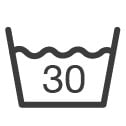
Your Guide to Laundry Symbols
Share
Washing

30°C Fine Wash.
Washing cycle suggested for dark colored garments made in cotton, polyester, or mixed fabrications.

30°C Mild Fine Wash.
Reduce the quantity of laundry so that the drum is not too full. Select an appropriate washing program. Avoid spinning or do spin for short periods only to minimize the risk of creasing.

30°C Very Mild Fine Wash.
This washing cycle ensures a much reduced mechanical treatment – by this we mean there is reduced agitation on the garment and reduced spinning pressure. Reduce the quantity of laundry and select an appropriate washing program.

Hand Wash.
Hand wash at a water temperature between 30°c and 40°c, depending on the garment. First, dissolve a fine detergent in plenty of water. Allow the garment to float in the solution and agitate carefully, before rinsing well. Press the extra water out carefully using a towel and reshape gently.

Do Not Wash.
Any articles marked in this way must not be washed. They may be sensitive to any kind of wet treatment or be unsuitable for washing in a domestic washing machine because of their size.
Bleaching

Any Bleach Allowed.
The empty triangle is the symbol for chlorine and oxygen bleach.

Only Oxygen Bleach Allowed.
The triangle with two oblique lines indicates that oxygen bleach is permitted but not chlorine bleach.

Do Not Bleach.
The triangle with a diagonal cross indicates that bleaching is not allowed. Use only bleach-free detergent.
Tumble Drying

Normal Drying.
Drying in the tumble dryer is possible under normal load.

Mild Drying.
Select a mild cycle with reduced temperature and duration of treatment.

Do Not Tumble Dry.
This garment is unsuitable for tumble drying.

Hot Iron.
Iron at maximum sole plate temperature of 200°C. A steam iron may be used.

Iron at Moderate Temperature.
Iron at maximum sole plate temperature of 150 °C. A steam iron can be used. Avoid heavy pressure.

Iron at Low Temperature.
Iron at maximum sole plate temperature of 110 °C. Shiny or pressure-sensitive pieces should be ironed with a press cloth or inside out.

Do Not Iron.
Irreversible changes must be expected if an iron is used.
Dry Cleaning

Professional Dry-Cleaning.
Normal dry cleaning process can be used with no restrictions. Commercial stain removers on a solvent base may be used with some restrictions.

Professional Dry-Cleaning (Hydrocarbons).
Normal dry cleaning process can be used with no limitations. Commercial stain removers on a solvent base may not be used.

Do Not Dry-Clean.
No professional dry-cleaning allowed. Do not use stain removers that contain solvents.
